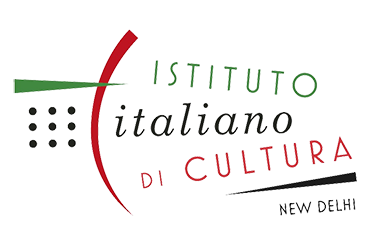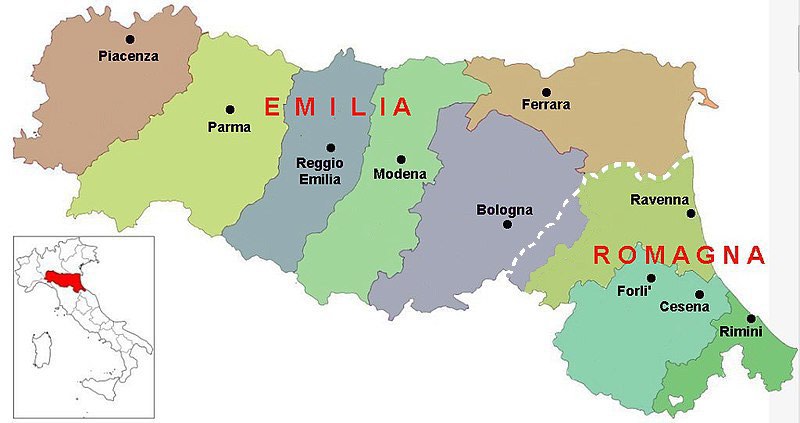Part 4 – Emilia: Continuation of our trip in Emilia, discovering the beautiful cities of Parma, Piacenza and Reggio Emilia
We will continue our trip in Emilia, discovering the beautiful cities of Parma, Piacenza and Reggio Emilia. Like the destinations we have visited in the last post, these three cities are rich in history, art, and gastronomy tradition.
Parma
If there is an Italian city famous for its typical culinary products, that must be Parma.
It gives its name to the most celebrated charcuterie in the country, the Parma ham. News about the production of this cold cut can be found already in the Ancient Rome age. Over the centuries, many historians have described the techniques with which the inhabitants of this province realized salted hams.
In 1996 the European Community assigned to Parma ham the title of DOP, a product with a protected denomination of origin. This certification means that only hams produced in that area, and only with the established traditional procedures and ingredients, can use the name “Parma ham”.


But Parma isn’t well-known only for its extraordinary food. The city offers many important monuments, churches, and the amazing National Art Gallery. Let’s start the tour from Piazza del Duomo (Cathedral square). Its astonishing beauty seems to have been taken directly from a painting. The three main buildings that surround the square, the Cathedral, the Baptistery and the Bishop’s Palace, work together to build a unique scenography impossible to miss.
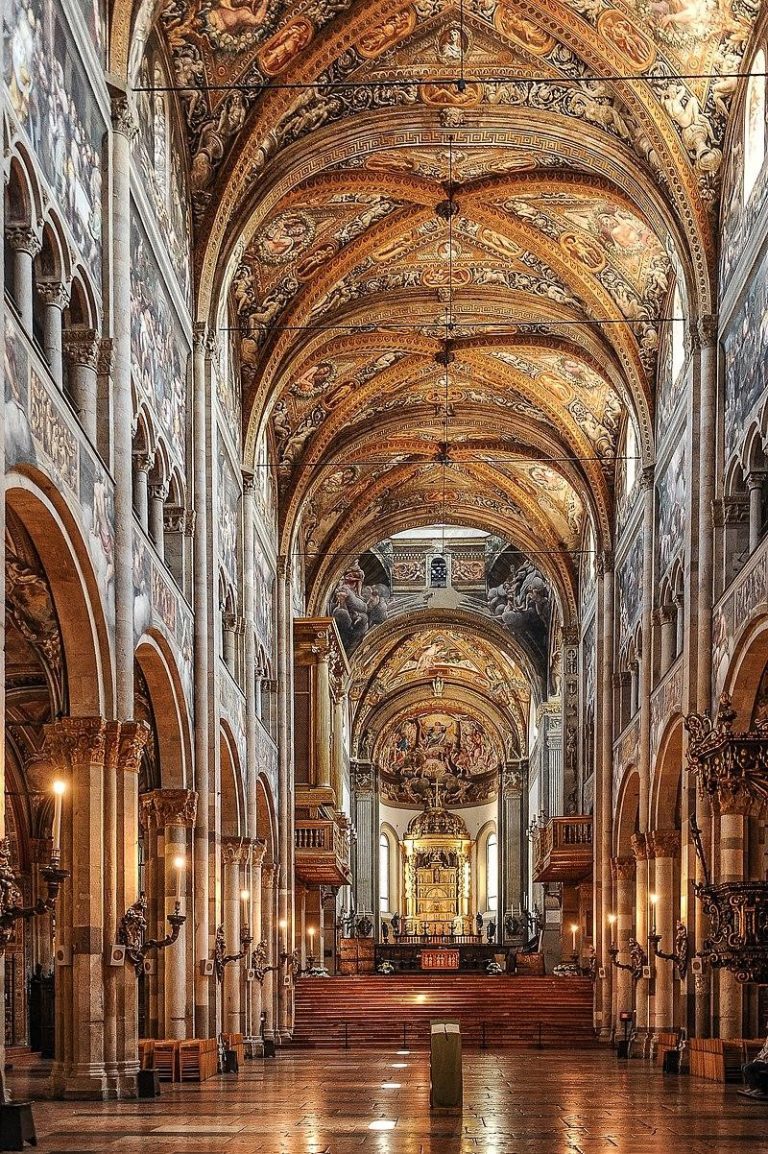
With its beautiful facade and the tall bell tower, the Cathedral is the first monument to attract the visitor’s attention. Dedicated to the Assumption of the Blessed Virgin Mary, the place of worship was consecrated in 1106. Its exterior, built in Romanesque style, presents a gabled facade typical of the Northern Italy architecture.
In the interior of the Cathedral it is possible to see the original Romanesque structure, even if over the centuries it has received many adjunctions and restorations in Renaissance style. There are also some lateral chapels from the Gothic period.


On the right side of the church stands the 63
meters high bell tower. It was built between 1284 and 1294 to replace a previous construction. It is made of dark bricks, while its corners are
realized with light marble blocks.
And next to it, another marvellous gem of
Parma’s architecture. We are talking about the Baptistery. Built by Benedetto Antelami at the end of the 12th Century, the structure strikes for the use of pink marbles from Verona on its surface.
It was located above a stream of water which was used to refill the big batismal font in its interior. On the octagonal facade are represented scenes from the New Testament.
On the opposite side of Piazza del Duomo sits
the Bishop’s palace, which dates back to the 11th Century. The building has been renovated in various occasions, but it still presents some of its original medieval and Renaissance characteristic elements.
One area of the Palace hosts the Diocese museum, which preserves pieces of art from the Cathedral and Baptistery, but also Roman mosaics from the 5th Century.


Another unmissable point of interest in Parma is the monumental complex of Palazzo della Pilotta. Wanted by the Duke Ottavio Farnese at the end of the 16th Century, the complex is now the venue of the National Archeological Museum, the Palatina library, the Farnese theater and the National Art Gallery.
The latter offers an amazing opportunity to admire works from Beato Angelico, Correggio, Parmigianino, Leonardo Da Vinci, El Greco, Tintoretto, Tiepolo and many others.
Piacenza
Piacenza is a town with slightly over 100.000 inhabitants located at the border between Emilia and Lombardy. Its pinnacle point in history arrived in the 16th Century during the ruling of the Farnese family, which made Piacenza a rich, powerful and beautiful town.
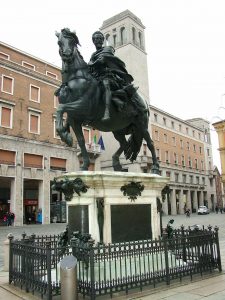
The heart of the town is represented by the central Piazza Cavalli (Horses square). It takes its name from the big bronze statues which portray Alessandro Farnese and his son Ranuccio riding two horses. The author of the pieces is the Tuscan sculptor Francesco Monchi.
Another symbol of the city is Palazzo Gotico. It is easily recognizable thanks to its facades, built with two different materials. In the lower part of the building was used pink marbles from Verona; while in the top area the choice fell on terracotta bricks. The Palace was commissioned in 1281 by the lord Alberto Scoto, leader of the merchants, as venue for the political power of the city.

The use of two different materials is the characteristic of the exterior or another Piacenza’s monument, the Cathedral. In this case the bicolor effect is made by pink marble on the base, and sandstone on the top. The highlights of the church are the baptismal font from the 5th Century, and the cupola with frescoes by the Emilian painter Guercino. It is possible to climb some stairs to have a closer look of the dome.
The bell tower, from 1333, is 72,5 meters high and is topped by a statue of an angel that works also as a wind vane.
Worth a visit is also the Kronos Museum. On the first floor of the building is possible to admire a triptych from the 14th Century by Serafino De’ Serafini, and some beautiful pieces from the painter Guido Reni. The second floor is dedicated to the relics, while on the third level is preserved the Code 65, a mysterious medieval book dating back to 1100, which includes notions about many different subjects like astronomy and astrology, agriculture, and medicine.
Piacenza’s gastronomy boasts a rich and varied tradition. Thanks to its geographical position, it has received influences also from the bordering Italian regions of Lombardy, Piedmont and Liguria.

Some of the main typical products of this province are pork cold cuts, like salame, pancetta and coppa. Also, like in the rest of Emilia, Piacenza has its own kind of filled pasta, called anolini. It is another version of tortellini, filled with meat, bread crumbles, Parmigiano cheese, eggs and nutmeg, and boiled in meat broth. On Christmas eve, family from Piacenza meet to prepare the anolini for the lunch of the 25th of December.
Piacenza is well-known for its wines, produced in the hills around the city. Traces of the cultivation of grapes in the area date back to 2000 and 700 BC. In the Roman age Piacenza’s wines were already famous, and it is documented that in the 13th Century AD they were exported to France.

The main wine produced here is Gutturnio, which in 1967 was awarded with the Denomination of Controlled Origin title. It is a soft, well rounded red wine with cherry like aromas.
Reggio Emilia
Our next and last stop will be Reggio Emilia. The main sightseeing worthy monuments of the city are located in the central Piazza Prampolini. Dedicated to the socialist politician Camillo Prampolini, born in Reggio Emilia in 1859, the square is surrounded by many important buildings.

The first is the Cathedral, with the Baptistery and the Bishop’s Palace. The cathedral is dedicated to the Assumption of the Virgin Mary. Traces of the existence of a church in that location date back to 451 AD. But the current structure was built between the 13th and the 16th Century. The facade, which is incomplete, presents a coating designed by the architect Prospeto Sogari.

On the top of the facade sits a big octagonal tower, with a huge statue of the Virgin Mary and the Infant Jesus on her lap.
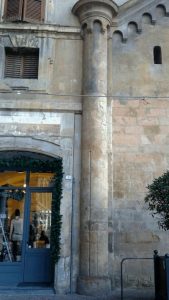
Next to the Cathedral there is the Baptistery. It is not as flashy as the one in Parma, but it is equally important. In fact, it preserves two historic measuring tools used by the citizens to avoid being scammed at the local cloth market. They were called “braccio reggiano” (Reggio’s arm), which equals 641 cm, and “pertica”, which correspond to six arms.
In Piazza Prampolini it is possible to visit also Palazzo del Monte di Pietà, easily recognizable thanks to its bell tower. In front of the Palace there is a bronze statue of a young man which represents the Crostolo, a water stream that originally flowed through the city.
Reggio Emilia is also famous for being the location where the Italian flag was born. On the 7th of January 1797, an assembly of delegates of the newly created Cispadane Republic voted for the universal adoption of the green-white-red tricolor flag. This symbol became a leitmotif in the future Italian Unification process, completed in 1861.
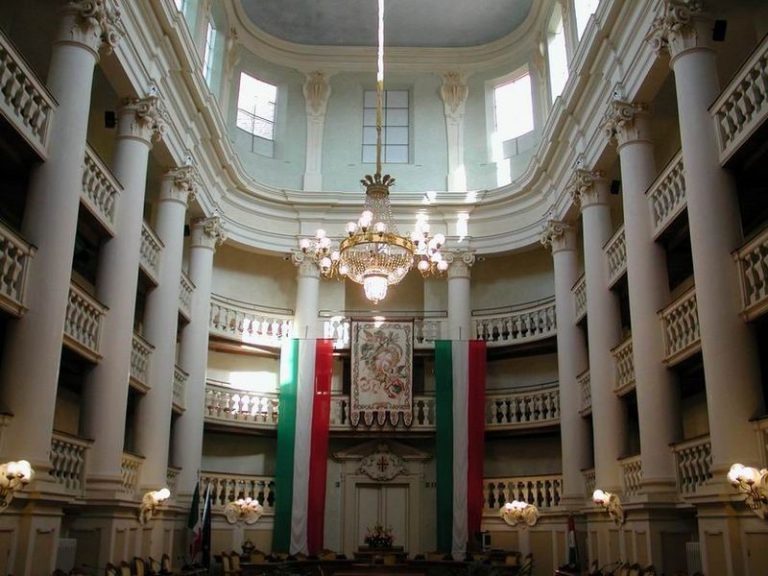
The venue of the assembly was a room of Reggio Emilia’s Town Hall. Now in the building it is possible to visit a small museum dedicated to the history of the tricolor flag.
Apart from tortellini, fried gnocchi and cold cuts, one of the protagonists of Reggio’s gastronomy is the erbazzone. It is a delicious savoury pie made with simple but great ingredients. To make a traditional ebrazzone, you must use spinaches, onions, garlic, bread crumbs, and cheese. The recipe also suggests putting some slices of pork lard on the top of the pie.

Parmigiano-Reggiano
We cannot conclude our tour of Emilia without talking about the culinary star of the region. Of course, we are talking about Parmigiano-Reggiano. Probably one of the most famous cheeses in the world, Parmigiano is a symbol of Italian gastronomy.
It was firstly introduced probably around the 12th Century, in the abbeys located between Reggio Emilia and Parma. A complete cheese wheel of Parmigiano must weigh between 30 and 40 kg, and for its production are used around 550 liters of unpasteurised cow’s milk. Then it must dry for a minimum period of 12 months.
It can be eaten in slivers and chunks, or grated over pasta dishes, soups and risottos. It is possible to use also its crust, that gives an amazing flavour to vegetable and meat broths.

The name “Parmigiano-Reggiano” is legally protected, and can be used only on the productions coming from Emilia, and matching some standards established by the Italian government. It is different from generic Parmesan cheese, which can be produced anywhere in the world.
